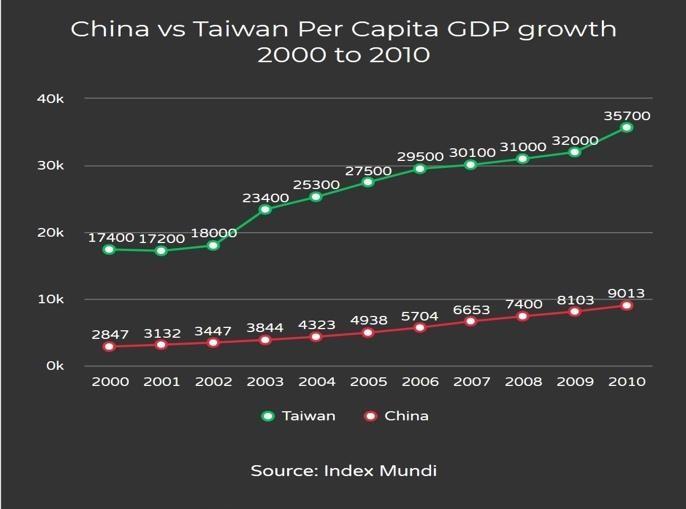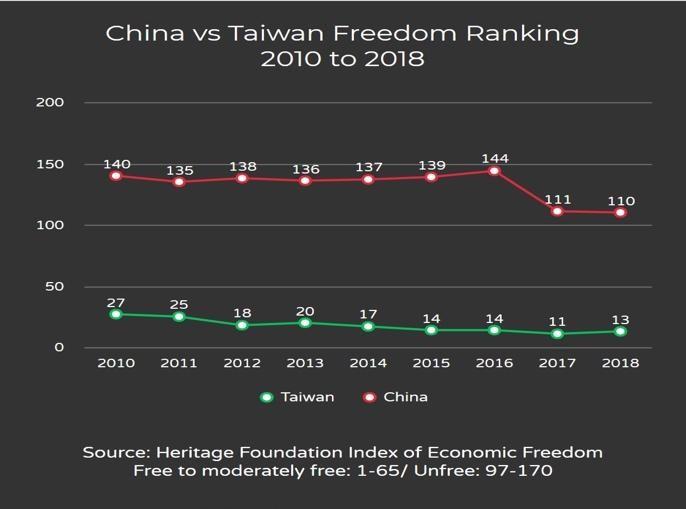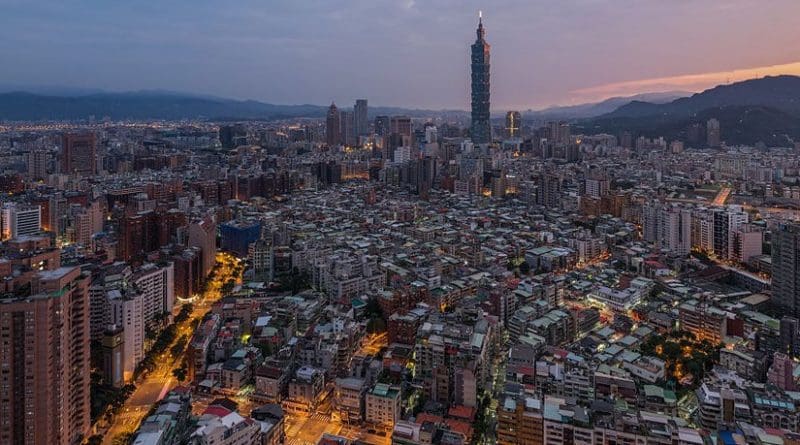Why Taiwan Grew Rich While The Mainland Starved – OpEd
By MISES
By José Niño*
Over the past few months, tensions between China and Taiwan have mounted. Chinese President Xi Jinping recently expressed his desire to unify the island nation with the Chinese mainland, and did not discard the option of using armed force to realize this goal.
Since end of the Chinese Civil War in 1949, which saw Taiwan break apart from the Chinese mainland, China has treated Taiwan as a rogue province and does not acknowledge its existence as an independent nation. Even in 2019, the two nations are still not on amicable terms. Taiwan recently ran large-scale military drills in preparation for a potential invasion by China. The Chinese Communist would love nothing more than to annex Taiwan and bring it within its political orbit. Taiwan, on the other hand, has a lot to fear about falling under Beijing’s thumb. The integrity of its relatively free economy could be at peril, along with its high standard of living.
Since the 1980s, Taiwan has embraced free-market policies that have catapulted the country into the higher echelons of economic development. Taiwan boasts a per capita GDP of $48,095 and is ranked as the thirteenth-freest economy in the world according to the Heritage Foundation’s 2018 Index of Economic Freedom. The island nation also received glowing reviews from the Fraser Institute’s 2018 Human Freedom Index, which put it in tenth place .
How Taiwan came to be one of the most prominent economic miracle stories is a tale of Cold War politics mixed with a firm devotion to market reforms into the twenty-first century.
Taiwan was originally part of the Chinese mainland. Following the fall of Qing dynasty, China experienced political fragmentation until nationalist leader Chiang Kai-Shek gained power in 1928.
In the same time frame, Communists led by guerilla stalwart Mao Zedong started to gain prominence and eventually came to blows with Chiang Kai-Shek’s nationalist government. The Japanese invasion of 1937 united the Communists and Nationalists in China for the time being.
But once the smoke cleared from World War II, the Communists decided it was the perfect opportunity to strike. The Communists successfully cemented their grip over China during the Chinese Communist Revolution of 1949, and the nationalists retreated to the island of modern-day Taiwan to establish the de facto Republic of China.
Taiwan’s early years as an independent nation were rather shaky due to Chiang’s authoritarian rule. Under his iron grip, the country went down the path of import-substitution, which entailed protectionism and the subsidization of strategic industries. Nevertheless, unlike the mainland, the country still maintained some semblance of property rights and left some breathing room for private industry. From 1952 to 1982, Taiwan had an average growth rate of 8.7 percent, while its gross national product grew by 360 percent from 1965 to 1986.
Markets: Taiwan’s Secret Weapon
After Chiang Kai-Shek’s death in 1975, Taiwan embraced a more hands-off approach to economic policy. By the 2000s, Taiwan was well on its way to becoming a market economy.
Throughout the 2000s, Taiwan exercised considerable fiscal restraint. Specifically, from 2001 to 2006, Taiwan implemented several spending freezes that allowed the private sector to grow faster than the government. In this period of fiscal restraint, government spending fell as a share of total GDP.
Unlike other countries, Taiwan has doubled down on its market reforms. Chris Edwards notes that Taiwan in 2010 cut its corporate taxes from 20 percent down to 17 percent. This current rate is among the lowest corporate tax rates of developed countries.
On the other hand, China can learn a thing or two from the island nation.
How Taiwan Beats China
China’s history throughout the 20th century was one of economic totalitarianism. Under Communist dictator Mao Zedong, China initiated the Great Leap Forward, a large-scale effort to collectivize the Chinese economy under the Chinese state’s thumb. Market mechanisms were completely out of the picture.
Not only did the Great Leap Forward destroy China’s productive sector, but it also left millions starving due to the Chinese government’s excessive tampering in the agricultural sector. Mao Zedong’s reputation took a hit after this failed socialist experiment but it did not stop him from pursuing other means of social engineering like the Cultural Revolution of 1966 to 1976.
Thankfully, cooler heads prevailed once Deng Xiaoping came into the political scene. Deng acknowledged that a new path was needed to bring the country back to its feet.
He implemented several market reforms such as land privatization and the establishment of special economic zones that would make the country more attractive to foreign investment. Although limited in scope, China’s reforms had an immediate impact. From 1978 to 2013, China’s annual GDP growth rate was estimated to be somewhere in the ballpark of 9.5 to 11.5 percent.
That being said, China still has its work cut out for it. In fact, Taiwan’s more consistent dedication to liberalization has allowed the country to enjoy a higher standard of living than China.
China is only ranked 110th on the Heritage Foundation’s Index of Economic Freedom, whereas Taiwan finds itself in an envious 13th place. Similarly, China receives questionable marks from The Fraser Institute’s Human Freedom Index, where it finds itself in 135th place. On the other hand, Taiwan is ranked in 10 th place. China’s per capita GDP is a mediocre $15,399, while Taiwan’s per capita GDP is $48,095.

China is only ranked 110th on the Heritage Foundation’s Index of Economic Freedom, whereas Taiwan finds itself in an envious 13th place. Similarly, China receives questionable marks from The Fraser Institute’s Human Freedom Index, where it finds itself in 135th place. On the other hand, Taiwan is ranked in 10 th place. China’s per capita GDP is a mediocre $15,399, while Taiwan’s per capita GDP is $48,095.

Taiwan offers an important lesson as far as state development is considered. F.A. Hayek might have actually been on to something when he asserted that smaller political units are more conducive to economic freedom and prosperity.
In the Road to Serfdom, Hayek praised states like Switzerland and the Netherlands for their maintenance of smaller political units:
I believe that here the experience of the small countries like Holland and Switzerland contains much from which even the most fortunate larger countries like Great Britain can learn . We shall all be the gainers if we can create a world fit for small states to live in.
Taiwan is a country of more than 23 million people, while China has about 1.4 billion people.
The Taiwanese case demonstrates that countries should consider scaling down and even breaking up their jurisdictions as a means of promoting prosperity while maintaining a cohesive social environment.
When it comes to political stability, bigger is not always better.
*About the author: Jose Nino is a Venezuelan-American political activist based in Fort Collins, Colorado. Contact: twitter or email him here.
Source: This article was published by the MISES Insititute


“Taiwan’s early years as an independent nation were rather shaky due to Chiang’s authoritarian rule.”
That’s an interesting way of describing the White Terror that followed the 228 Incident where thousands were killed. I hope you’re ware that during the much-lauded era of “property rights”, tens of thousands of Taiwanese were arrested, executed, or disappeared? Taiwan was a one-party right-wing dictatorship, which I suppose looked more positive against the backdrop of China’s revolutionary leftist totalitarian rule (unless you were one of the Taiwanese majority being beaten for things as mundane as speaking Japanese or even Taiwanese by the Nationalist secret police apparatus. From 1952 to 1982, millions of Taiwanese still lived in poverty or outright starved (though fortunately, we did not have any famines comparable to what you saw in China), though as long as their was “growth” I suppose actual poverty doesn’t matter (we can call that “economically correct” speech). Unless you’re one of those of the mind that murder isn’t actually murder provided you call them “communist bandits” prior to lining them up against the wall and shooting them–which continued well into the 1960s and 1970s–I wonder just how much you’d call that “liberalization” rather than “market-friendly totalitarianism” before Chiang Ching-kuo’s move towards actual democratization towards the end of his rule.
As an actual Taiwanese person, I’m grateful that the end of the dictatorship saw not just the rise of actual democratization but the creation of the new Taiwanese social safety net (instead of one that prioritized keeping the number of Taiwanese laborers, the needed fuel for Chinese-owned industries, who died every year at a convenient minimum). Though many economists have theorized our hyper-mercantile export economic model is not sustainable, I’m grateful we’ve taken our experience from the White Terror and decided that ruthless capitalism ought to be tempered by the values of majority-led rule of law.